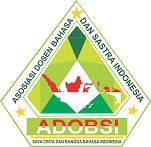Konteks dan Inferensi Film Dilan 1991 Karya Pidi Baiq
DOI:
https://doi.org/10.21776/ub.hastawiyata.2020.003.02.04Keywords:
context, inference, film.Abstract
Abstract
Each utterance certainly has a context for constructing a speech so that the direction of the conversation with the speech partner becomes clear. The discovery of context in discourse can be found in various objects including in the film. Film connoisseurs must be able to understand or interpret certain meanings (inference) based on the speech in the film, in order to fully understand the purpose and purpose of the speech. Therefore, this study aims to describe the context and inference on the 1991 film by Pidi Baiq. This study uses the method of referring to the note-taking technique (recording / transcribing dialogue in the 1991 Dilan film). The data analysis method used is the matching method, sub-types, the determining tool is the result of language capture by the speech partner. The basic technique used is the determining element or PUP technique. The tool is the mental power that is possessed by the researcher, namely referential disaggregation and pragmatic disaggregation. The method of informal presentation is used in this research, namely the formulation with ordinary words. In the 1991 film Dilan by Pidi Baiq found: (i) the principle of locational interpretation; (ii) the principle of temporal interpretation; (iii) the principle of analogy; and (iv) inference. Each of these discussions has its own characteristics to describe a meaning in a discourse. This is related to the meaning that can be conveyed well to the reader and listene, will have a mental impact after understanding the meaning of the discourse.
Keywords: context, inference, film.
References
Affandi, S. R. R. (2015). Inferensi Percakapan dalam Serial Drama Ryokiteki Na Kanojo Karya Iyoda Hidenori. E-Journal Linguistik Bahasa Jepang, 03(2), 100–113.
Brown, G., & Yule. (1983). Discourse Analysis I (Analisis Wacana). Jakarta: Gramedia Pustaka Utama.
Halliday, & Hasan. (1985). Bahasa, Konteks, dan Teks: Aspek-aspek Bahasa dalam Pandangan Semiotika Sosial. Yogyakarta: Gajah Mada University Press.
Mahsun. (2005). Metode Penelitian Bahasa. Jakarta: PT Raja Grafindo Persada.
Mulyana. (2005). Kajian Wacana. Yogyakarta: Tiara Wacana.
Ningtias. (2014). Analisis Konteks dan Implikatur pada Novel 5 cm Karya Donny Dhirgantoro. BASASTRA Jurnal Penelitian Bahasa, Sastra Indonesia Dan Pengajarannya, 2(3), 1–17.
Seyawati, N. (2017). Konteks dan Inferensi Wacana Motivasi Mario Teguh di Jejaring Sosial. PIBSI, (November), 608–621.
Soetikno, I. (1996). Analisis Wacana. Jakarta: PT Gramedia Pustaka Utama.
Sudaryanto. (2015). Metode dan Aneka Teknik Analisis data. Yogyakarta: Duta Wacana University.
Sumarlam. (2003). Teori dan Praktek Analisis Wacana. Surakarta: Pustaka Cakra.
Sumarlam. (2009). Analisis Wacana. Surakarta: Pustaka Cakra.














